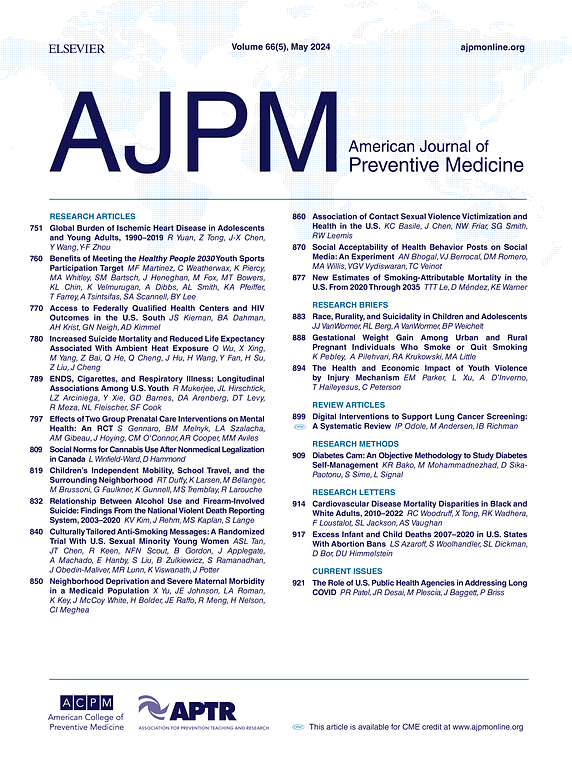Sex Differences in Methamphetamine Mortality in the United States: Heroin and Fentanyl Coinvolvement, 1999–2021
IF 4.3
2区 医学
Q1 MEDICINE, GENERAL & INTERNAL
引用次数: 0
Abstract
Introduction
Prepandemic data suggests that methamphetamine-related mortality and opioid coinvolvement have been increasing in the U.S. However, there was a staggering number of U.S. drug overdose deaths in 2020 and 2021, particularly among males. An updated examination of sex-specific trends in methamphetamine-related mortality, the extent to which these deaths may be driven by the heroin and fentanyl coinvolvement, and whether this coinvolvement might explain the disproportionate number of male methamphetamine deaths is warranted.
Methods
The authors leveraged final and provisional data from the CDC WONDER multiple causes of death database to examine deaths involving methamphetamine (i.e., psychostimulants with abuse potential, ICD-10 code T43.6) and methamphetamine-related deaths that coinvolved heroin and/or synthetic opioids excluding methadone (ICD-10 code T40.4; e.g., fentanyl) among U.S. residents aged 15–74 years. The authors plotted age-adjusted methamphetamine mortality rates by sex and year and quantified the proportion of deaths with heroin/synthetic opioid coinvolvement. Finally, they used Joinpoint regression models to quantify sex-specific trends in methamphetamine mortality and the proportion of deaths with heroin and/or synthetic opioid coinvolvement.
Results
From 1999 to 2021, the methamphetamine-related mortality rate increased 58.8-fold among males (0.33 per 100,000 to 19.74 per 100,000) and 65.3-fold among females (0.12 per 100,000 to 7.96 per 100,000), with the greatest increases occurring between 2019 and 2021. The proportion of these deaths that coinvolved heroin and/or synthetic opioids increased among both males (13.1% to 61.5%) and females (7.7% to 63.1%) from 1999 to 2021.
Conclusions
Increasing methamphetamine-related mortality among males and females has been accompanied by a dramatic increase in the proportion of heroin and/or synthetic opioid coinvolvement among both sexes. Robust harm reduction efforts are needed to mitigate these increases, particularly for people who couse stimulants and opioids.
美国甲基苯丙胺死亡率的性别差异:美国甲基苯丙胺死亡率的性别差异:海洛因和芬太尼共同参与,1999-2021 年。
导言:大流行前的数据表明,在美国,甲基苯丙胺相关死亡率和阿片类药物共同参与率一直在上升。然而,2020 年和 2021 年美国吸毒过量死亡人数惊人,尤其是男性。我们有必要对甲基苯丙胺相关死亡率的性别特异性趋势、这些死亡在多大程度上可能受海洛因和芬太尼共同参与的驱动,以及这种共同参与是否可以解释男性甲基苯丙胺死亡人数过多的原因进行最新研究:我们利用疾病预防控制中心WONDER多种死因数据库中的最终和临时数据,研究了美国15-74岁居民中涉及甲基苯丙胺(即具有滥用潜力的精神兴奋剂,ICD-10代码T43.6)的死亡案例,以及同时涉及海洛因和/或合成阿片类药物(不包括美沙酮)(ICD-10代码T40.4;如芬太尼)的甲基苯丙胺相关死亡案例。我们按性别和年份绘制了经年龄调整的甲基苯丙胺死亡率图,并量化了与海洛因/合成阿片类药物共同参与的死亡比例。最后,我们使用连接点回归模型来量化甲基苯丙胺死亡率的性别特异性趋势以及与海洛因和/或合成阿片类药物共同参与的死亡比例:从 1999 年到 2021 年,甲基苯丙胺相关死亡率在男性中增加了 58.8 倍(从每 10 万人中 0.33 例增加到每 10 万人中 19.74 例),在女性中增加了 65.3 倍(从每 10 万人中 0.12 例增加到每 10 万人中 7.96 例),最大增幅出现在 2019 年到 2021 年之间。从1999年到2021年,男性(13.1%到61.5%)和女性(7.7%到63.1%)中与海洛因和/或合成类阿片共同相关的死亡比例均有所上升:结论:在男性和女性甲基苯丙胺相关死亡率上升的同时,男女共同吸食海洛因和/或合成类阿片的比例也急剧上升。需要采取强有力的减低伤害措施来缓解这些增长,特别是对于同时使用兴奋剂和阿片类药物的人群。
本文章由计算机程序翻译,如有差异,请以英文原文为准。
求助全文
约1分钟内获得全文
求助全文
来源期刊

American Journal of Preventive Medicine
医学-公共卫生、环境卫生与职业卫生
CiteScore
8.60
自引率
1.80%
发文量
395
审稿时长
32 days
期刊介绍:
The American Journal of Preventive Medicine is the official journal of the American College of Preventive Medicine and the Association for Prevention Teaching and Research. It publishes articles in the areas of prevention research, teaching, practice and policy. Original research is published on interventions aimed at the prevention of chronic and acute disease and the promotion of individual and community health.
Of particular emphasis are papers that address the primary and secondary prevention of important clinical, behavioral and public health issues such as injury and violence, infectious disease, women''s health, smoking, sedentary behaviors and physical activity, nutrition, diabetes, obesity, and substance use disorders. Papers also address educational initiatives aimed at improving the ability of health professionals to provide effective clinical prevention and public health services. Papers on health services research pertinent to prevention and public health are also published. The journal also publishes official policy statements from the two co-sponsoring organizations, review articles, media reviews, and editorials. Finally, the journal periodically publishes supplements and special theme issues devoted to areas of current interest to the prevention community.
 求助内容:
求助内容: 应助结果提醒方式:
应助结果提醒方式:


